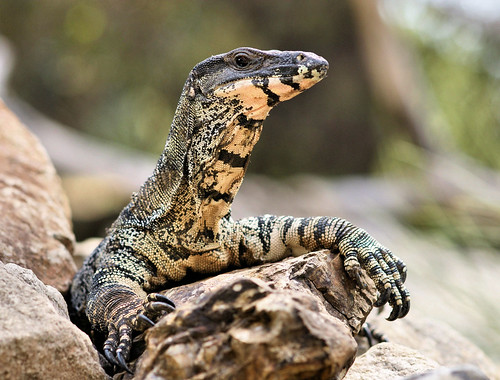Post by DinosaurMichael on Mar 10, 2012 18:18:23 GMT -5
BoarCroc - Kaprosuchus saharicus
Kaprosuchus is an extinct genus of mahajangasuchid crocodyliform. It is known from a single nearly complete skull collected from the Upper Cretaceous Echkar Formation of Niger. The name means "boar crocodile" from the Greek kapros ("boar") and souchos ("crocodile") in reference to its unusually large caniniform teeth which resemble those of a boar. It has been nicknamed "BoarCroc" by Paul Sereno and Hans Larsson, who first described the genus in a monograph published in ZooKeys in 2009 along with other Saharan crocodyliformes such as Anatosuchus and Laganosuchus. The type species is K. saharicus. Kaprosuchus is estimated to have been around 6 metres (20 feet) in length. It possesses three sets of tusk-like caniniform teeth that project above and below the skull, one of which in the lower jaw fits into notches in upper jaw. This type of dentition is not seen in any other known crocodyliform. Another unique characteristic of Kaprosuchus is the presence of large, rugose horns formed from the squamosal and parietal bones that project posteriorly from the skull. Smaller projections are also seen in the closely related Mahajangasuchus. The snout of Kaprosuchus shows generalized proportions and the naris is positioned dorsally. In Kaprosuchus many teeth are hypertrophied and labiolingually (laterally) compressed, unlike those of crocodyliforms with similarly shallow snouts, which are usually subconical and of moderate length. Another difference between the skull of Kaprosuchus and those of crocodyliforms that also possess dorsoventrally compressed snouts is the great depth of the posterior portion of the skull. In Kaprosuchus, the orbits (i.e., eye sockets) open laterally and are angled slightly forward rather than upward. The orbits turned forward suggest that there was somewhat stereoscopic vision, i.e., an overlap in the visual field of the animal. The surfaces of the premaxillae are rugose with the edges elevated above the body of the bone, suggesting that a keratinous shield would have been supported by the rugosities at the tip of the snout. Along the interpremaxillary suture, the area where the two premaxillae meet, the surface is smooth, giving the paired rugosity of the premaxillae the resemblance of a moustache in anterior view.

Megalania - Varanus priscus
Megalania ("great roamer"; Greek Μέγας "great" + ἀλαίνω "roam") is a giant extinct goanna or monitor lizard. It was part of a megafaunal assemblage that inhabited southern Australia during the Pleistocene, and appears to have disappeared around 40,000 years ago. The first aboriginal settlers of Australia may have encountered living Megalania. The name Megalania prisca was coined by Sir Richard Owen to mean "Ancient Great Roamer"; the name was intended to "reference to the terrestrial nature of the great Saurian". Owen used a modification of the Greek word ἠλαίνω ēlainō ("I roam"). The close similarity to the Latin word: lania (feminine form of "butcher") has resulted in numerous taxonomic and popular descriptions of Megalania mistranslating the name as: Ancient Giant Butcher. Megalania prisca was originally classified in its own monotypic genus. Its status as a valid genus remains controversial, with many authors preferring to consider it a junior synonym of Varanus, which encompasses all living monitor lizards. As the gender of the genera Megalania and Varanus are different (feminine and masculine, respectively), the epithet prisca changes to priscus (in alignment with the Code of the ICZN). Several studies have attempted to establish the phylogenetic position of Megalania within the Varanidae. An affinity with the Perentie, Australia's largest living lizard, has been suggested based on skull-roof morphology. The most recent comprehensive study proposes a sister-taxon relationship with the Komodo dragon based on neurocranial similarities, with the Lace monitor as the closest living Australian relative. Conversely, the Perentie is considered more closely related to the Gould's and Argus monitors. The lack of complete, or nearly complete fossil skeletons has made it difficult to determine the exact dimensions of Megalania. Early estimates placed the length of the largest individuals at 7 metres (23 ft), with a maximum weight of approximately 600–620 kilograms (1,300–1,400 lb). However, more recent and more rigorous studies give very different results from one another. In 2002, Stephen Wroe determined that Megalania had a maximum length of 4.5 metres (15 ft) and a weight of 331 kilograms (730 lb), while its average length would have been around 3.5 metres (11 ft), and mean body weight would have been between 97–158 kilograms (210–350 lb). He concluded that the earlier estimates reaching lengths of 6 metres (20 ft) or more and a weight of several tons were exaggerations based upon flawed methodologies. However, Ralph Molnar in 2004 determined a range of potential sizes for Megalania (made by scaling up from dorsal vertebrae, after he determined a relationship between dorsal vertebrae length and total body length). If it had a long thin tail like the Lace monitor (Varanus varius), then it would have reached a length of 7.9 metres (26 ft), while if its tail-to-body proportions were more similar to that of the Komodo dragon, then a length of around 7 metres (23 ft) is more likely. Taking the maximal 7 m length, he estimated a weight of 1,940 kilograms (4,300 lb), with a leaner 320 kilograms (710 lb) being average.

Kaprosuchus is an extinct genus of mahajangasuchid crocodyliform. It is known from a single nearly complete skull collected from the Upper Cretaceous Echkar Formation of Niger. The name means "boar crocodile" from the Greek kapros ("boar") and souchos ("crocodile") in reference to its unusually large caniniform teeth which resemble those of a boar. It has been nicknamed "BoarCroc" by Paul Sereno and Hans Larsson, who first described the genus in a monograph published in ZooKeys in 2009 along with other Saharan crocodyliformes such as Anatosuchus and Laganosuchus. The type species is K. saharicus. Kaprosuchus is estimated to have been around 6 metres (20 feet) in length. It possesses three sets of tusk-like caniniform teeth that project above and below the skull, one of which in the lower jaw fits into notches in upper jaw. This type of dentition is not seen in any other known crocodyliform. Another unique characteristic of Kaprosuchus is the presence of large, rugose horns formed from the squamosal and parietal bones that project posteriorly from the skull. Smaller projections are also seen in the closely related Mahajangasuchus. The snout of Kaprosuchus shows generalized proportions and the naris is positioned dorsally. In Kaprosuchus many teeth are hypertrophied and labiolingually (laterally) compressed, unlike those of crocodyliforms with similarly shallow snouts, which are usually subconical and of moderate length. Another difference between the skull of Kaprosuchus and those of crocodyliforms that also possess dorsoventrally compressed snouts is the great depth of the posterior portion of the skull. In Kaprosuchus, the orbits (i.e., eye sockets) open laterally and are angled slightly forward rather than upward. The orbits turned forward suggest that there was somewhat stereoscopic vision, i.e., an overlap in the visual field of the animal. The surfaces of the premaxillae are rugose with the edges elevated above the body of the bone, suggesting that a keratinous shield would have been supported by the rugosities at the tip of the snout. Along the interpremaxillary suture, the area where the two premaxillae meet, the surface is smooth, giving the paired rugosity of the premaxillae the resemblance of a moustache in anterior view.

Megalania - Varanus priscus
Megalania ("great roamer"; Greek Μέγας "great" + ἀλαίνω "roam") is a giant extinct goanna or monitor lizard. It was part of a megafaunal assemblage that inhabited southern Australia during the Pleistocene, and appears to have disappeared around 40,000 years ago. The first aboriginal settlers of Australia may have encountered living Megalania. The name Megalania prisca was coined by Sir Richard Owen to mean "Ancient Great Roamer"; the name was intended to "reference to the terrestrial nature of the great Saurian". Owen used a modification of the Greek word ἠλαίνω ēlainō ("I roam"). The close similarity to the Latin word: lania (feminine form of "butcher") has resulted in numerous taxonomic and popular descriptions of Megalania mistranslating the name as: Ancient Giant Butcher. Megalania prisca was originally classified in its own monotypic genus. Its status as a valid genus remains controversial, with many authors preferring to consider it a junior synonym of Varanus, which encompasses all living monitor lizards. As the gender of the genera Megalania and Varanus are different (feminine and masculine, respectively), the epithet prisca changes to priscus (in alignment with the Code of the ICZN). Several studies have attempted to establish the phylogenetic position of Megalania within the Varanidae. An affinity with the Perentie, Australia's largest living lizard, has been suggested based on skull-roof morphology. The most recent comprehensive study proposes a sister-taxon relationship with the Komodo dragon based on neurocranial similarities, with the Lace monitor as the closest living Australian relative. Conversely, the Perentie is considered more closely related to the Gould's and Argus monitors. The lack of complete, or nearly complete fossil skeletons has made it difficult to determine the exact dimensions of Megalania. Early estimates placed the length of the largest individuals at 7 metres (23 ft), with a maximum weight of approximately 600–620 kilograms (1,300–1,400 lb). However, more recent and more rigorous studies give very different results from one another. In 2002, Stephen Wroe determined that Megalania had a maximum length of 4.5 metres (15 ft) and a weight of 331 kilograms (730 lb), while its average length would have been around 3.5 metres (11 ft), and mean body weight would have been between 97–158 kilograms (210–350 lb). He concluded that the earlier estimates reaching lengths of 6 metres (20 ft) or more and a weight of several tons were exaggerations based upon flawed methodologies. However, Ralph Molnar in 2004 determined a range of potential sizes for Megalania (made by scaling up from dorsal vertebrae, after he determined a relationship between dorsal vertebrae length and total body length). If it had a long thin tail like the Lace monitor (Varanus varius), then it would have reached a length of 7.9 metres (26 ft), while if its tail-to-body proportions were more similar to that of the Komodo dragon, then a length of around 7 metres (23 ft) is more likely. Taking the maximal 7 m length, he estimated a weight of 1,940 kilograms (4,300 lb), with a leaner 320 kilograms (710 lb) being average.













